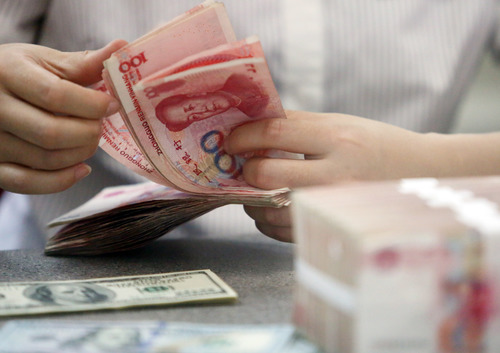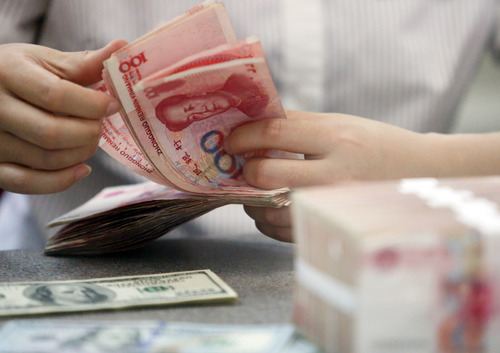
A worker counts Chinese currency Renminbi (RMB) at a bank in Linyi, east China's Shandong Province, Aug. 11, 2015.
BEIJING, Feb. 25 (Xinhua) -- Despite the in-chaos global financial market, the central parity rate of Chinese yuan or Renminbi (RMB) continued to strengthen to 6.328 against the U.S. dollar on Thursday.
After hitting a nearly 4-year high at 6.3178, up 178 pips by close on the spot market on Wednesday, the stronger onshore exchange rate of Chinese yuan/USD, as analysts reckoned, was not a sudden rise.
-- Relatively independent trend of yuan driven by its stronger "safe haven" properties
Since the start of February, Chinese yuan generally stabilized and strengthened in spite of the decreasing seasonable demand for foreign exchange settlement in China, with its exchange rate against the U.S. dollar up nearly 0.5 percent over February 11 last week, the largest weekly gain in the past 16 weeks.
Not only against the U.S. dollar, Chinese yuan also appreciated against other major foreign currencies. On February 22, data with the Bank for International Settlements showed that the nominal effective exchange rate index of the Chinese yuan in January climbed to 128.67, up 0.09 percent month on month and marking the ninth consecutive monthly increase and also an all-time high.
With the Ukraine issue, rising expectations on monetary policy normalization in major developed countries and recently significantly narrowed yield spread between Chinese and U.S. government bonds all supposed to weigh on the exchange rate of yuan, the strengthening of the Chinese currency attracted wide attention.
Analysts attributed the stronger Chinese yuan to the widespread risk aversion mood on global foreign exchange (forex) market, which gave rise to the "safe haven" properties of Chinese yuan-denominated assets and pillared up the stronger yuan.
Chang Ran, senior researcher with ZhiXin Investment Research Institute, said that Chinese yuan recently aroused close attentions from European and U.S. investment institutions with its relatively low volatility and stable purchasing power.
Recent weeks, global risk assets prices edged down amid the disturbances from geological factors and the U.S. rate hike hopes, which, in turn, enhanced the attractiveness of yuan-denominated assets.
As from the beginning of February, offshore yuan's exchange rate against the U.S. dollar remained slightly higher than the onshore yuan's, hinting relatively more long sales of yuan on international market, according to Chang.
As the forex team of the research department of China International Capital Corporation Limited held, the shrinking yield spread between Chinese and U.S. government bonds in January and Ukraine issue did not slow foreign investment in RMB-denominated bonds therefore the rapid appreciation of Chinese yuan might result from the external capital inflows into RMB assets.
-- No conditions for sustainable appreciation of RMB foreseeable
Currently, the downward correction process of Chinese yuan's exchange rate is interrupted by this bout of risk aversion sentiment and before the ebbing of the risk hating mood, RMB-denominated assets as a safe haven for global investors will support the exchange rate of yuan to further strengthen in the short term, according to the macro-economy research team of CIB Research.
However, the expected stronger Chinese yuan against the U.S. dollar will likely lead to further shrinkage of Chinese and U.S. government bond yield spread, which may add to the depreciation pressure for yuan.
In the mid- and long term, Chinese yuan faces temporary depreciation pressures mainly from three aspects, the weakening supports from the economic fundamental, lessening forex settlement demand if exports growth rebates and potential influences from cross-border capital flows, thought Liu Meng with financial market department of China Construction Bank.
In future, the exchange rate of Chinese yuan is still anticipated to boast certain resilience but no sustainable appreciation is foreseeable, believed Chang, adding that the trend of yuan's exchange rate may be largely independent and impacts from the possible U.S. rate hikes may be relatively limited.
Under such circumstances, the annual trend of yuan's exchange rate may be more balanced and the two-way fluctuation band of RMB's exchange rate may stay between 6.2-6.7 with relatively strong flexibility, Chang deemed. (Edited by Duan Jing with Xinhua Silk Road, duanjing@xinhua.org)




 A single purchase
A single purchase









